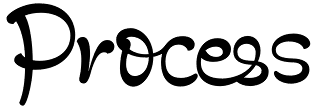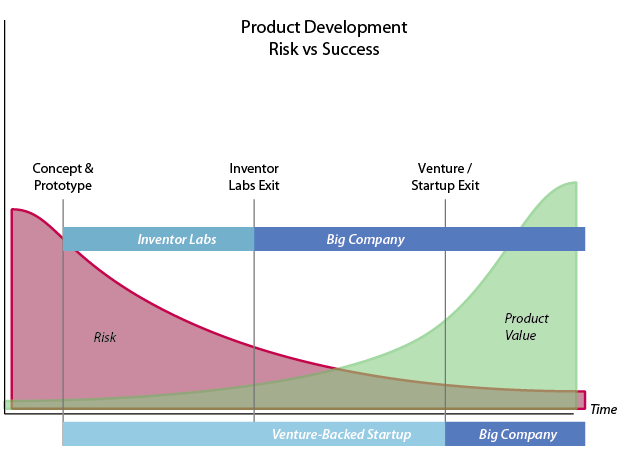
Our Model
Our Process
Bringing Products to Market
Brand new products get introduced to the world in various ways, but the most common is through a process whereby a startup company develops the product and proves there is a market for it, at which point a bigger company acquires the product and accelerates its success. We believe that the primary purpose of a startup is to remove risk and prove viability, and that big companies do not want to assume the risk, preferring to pay more for a product with some demonstrated success.

At Inventor Labs, we fulfill the role of the startup company in bringing a product to a point where a larger company will acquire it. We act as a virtual startup to many products, like an incubator.
Our Process
We develop products through a speculative process: we look at many ideas, assess the opportunities and risks, and develop several product ideas in parallel, knowing that some will perform better than others. Not all ideas will be accepted in the marketplace, so it's important to push only on the ones that are showing strong signs of market acceptance. We do this by doing market testing at all stages of development so we know as early as possible which ones will be winners.
Turning Ideas into Products
We consider an idea to be a problem statement and/or a solution, and a technology to be any kind of method, material, or intellectual property that could lead to one or more products.
In our University Program we look for promising ideas from faculty, students, and staff, who may have an inspiration for a product. We also seek out compelling research, intellectual property, and technologies that may not have found a practical application. We have criteria for selection which include market categories, manufacturing processes, defensible ideas (intellectual property), competition, and many other factors. We choose a select few of the ideas that come to us, and we put a lot of work into the ones we choose.
An idea or technology does not need to be protected with a patent in order to work with us. We will help the Inventor get a patent at the right time if the opportunity merits. We will keep all ideas and technologies in confidence and will always act as inclusively as possible in acknowledging the origins of all ideas and intellectual property.
A product is something that you can buy. It is manufactured, distributed, and otherwise made available for sale, and a successful product is the desired end result from Inventor Labs. We are shaping ideas and technologies into products, and finding the right partners to accelerate the success of those products.
Business Agreement
The way we work with Inventors is a bit like the way movie studios work with people who have written a screenplay. A screenplay is the intellectual property of its writer, but the process of making it into a movie requires investment, time, and expertise. If we select an idea, we will ask the Inventor to enter into an agreement with us to develop, market, and ultimately sell off the idea to a big manufacturer (or launch a startup company if the opportunity is large enough) and the Inventor shares in the outcome. The Inventor does not pay us anything. The Inventor, in conjunction with the Office of Technology Transfer for the University, assigns the intellectual property (idea) to us for a period of time not to exceed 24 months, during which Inventor Labs develops the idea and sells it off to an acquirer. If we can't sell the product successfully, we assign the intellectual property—and all assets that we have developed on your behalf—back to you.
It's important to note that we do not work on a royalty basis, but on a percentage of profit basis. The successful product exit (sale to acquirer) returns proceeds to the Inventor and to the University according to a fixed percentage of profits:
Researcher / Inventor |
5% |
University (if applicable) |
5% |
Inventor Labs |
5% |
Investment Fund |
85% |
In the event that a Corporation is formed and funded to spin out the idea, the ratios are preserved though it manifests as equity in the new Corporation, not a cash distribution.
Timeline
Our process is geared toward success. We believe that a viable idea can be tested, developed, and marketed in a relatively short amount of time, and we have a methodology for winnowing out the ideas that will perform best in the marketplace. Our development cycle looks like this, with approximate durations of time:
Phase / Milestone |
Months |
Description |
30-Day Investigation |
1 |
Solely at our own expense, Inventor Labs investigates the idea, opportunity, risks, and all, to decide whether or not to pursue it further. |
Decision to Develop |
|
An agreement is signed with Inventor to grant rights to the intellectual property, for a period not to exceed 24 months. |
Product / Customer Development |
6 |
Inventor Labs invests time and resources to develop the idea into a viable product. |
Decision to Manufacture |
|
Inventor Labs decides whether or not to go into short-run manufacturing to produce/sell product. |
Manufacturing / Sales |
6-18 |
Inventor Labs builds market share by selling the manufactured products. |
Sale / Exit for Product |
|
At any point in the timeline, Inventor Labs may choose to sell the rights to the developed product to a bigger company, on behalf of the Inventor. |
The End Point
When the idea is sold to an acquirer, our agreement with the Inventor terminates in a successful exit for the product and all rights, assets, and intellectual property are transferred to the acquirer. In the event that an acquirer is not found, or Inventor Labs chooses not to pursue the idea further, all rights, assets, and intellectual property are transferred back to the Inventor.
The key to our business model is to find the right point in the risk / proof timeline where an acquirer believes that the product is a viable addition to their product line. For some products this may come early in the cycle, as its value proves out easily, or the acquirer sees a way to make it successful. Other ideas may require more proof points and more incremental sales to show a low enough risk profile to make the product attractive for acquisition.

